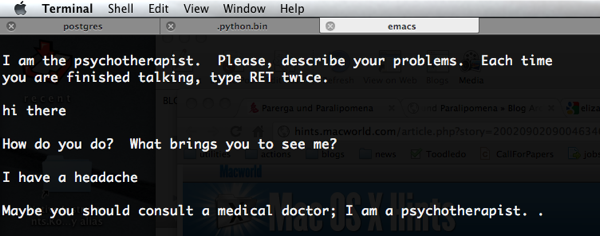A doctor hidden in your mac
What a treat to find a hidden AI gem in your computer. As it turns out, OS X comes with the simulated therapy program, Eliza, pre-installed. Eliza was written at MIT by Joseph Weizenbaum between 1964 to 1966, and it was one of the early examples of natural language processing.
On OSX, Eliza is 'hidden' inside the eMacs application.
Here's how you can open it: in the Terminal application type emacs and hit enter. When the editor has loaded, hold shift and hit the escape key. Then type xdoctor and hit return. Answer the first question and proceed from there. When you're done, control-X control-C will quit the editor.
Janet Murray, in her classic cyber-narrative book Hamlet on the Holodeck describes the invention with these words:
The resulting persona, Eliza, was that of a Rogerian therapist, the kind of clinician who echoes back the concerns of the patient without interpretation.
[...] To Weizenbaum's dismay, a wide range of people, including his own secretary, would "demand to be permitted to converse with the system in private, and would, after conversing with it for a time, insist, in spite of [Weizenbaum's] explanations, that the machine really understood them."
[...] Weizenbaum had set out to make a clever computer program and had unwittingly created a believable character. He was so disconcerted by his achievement that he wrote a book warning of the dangers of attributing human thought to machines.
Cite this blog post:
Comments via Github:
See also:
2015
paper ResQuotes.com: Turn your Notes and Highlights into Research Ideas
Force11 - Research Communications and e-Scholarship conference, Oxford, UK, Jan 2015.
2012
2009
